Faults as Windows to Monitor Gas Seepage: Application to CO2 Sequestration and CO2-EOR
Abstract
:1. Introduction
2. Materials and Methods
3. Results
3.1. Gas Fluxes and Shallow Soil Gas Results
3.2. Results for Nested Sampling of 10-m Holes
3.3. Faults as Pathways and Seals at Rangely and Teapot Dome
4. Discussion
5. Conclusions
Supplementary Materials
Acknowledgments
Conflicts of Interest
References
- Ciais, P.; Sabine, C. Chapter 6. Carbon and Other Biogeochemical Cycles. In Climate Change 2013: The Physical Science Basis; Contribution of Working Group I to the Fifth Assessment Report of the Intergovernmental Panel on Climate Change, Stocker, T.F., Qin, O., Plattner, G.-K., Tignor, M., Allen, S.K., Boschung, J., Nauels, A., Xia, Y., Bex, V., Midgley, P.M., Eds.; Cambridge University Press: New York, NY, USA, 2013; pp. 465–570. ISBN 978-1-107-05799-1. [Google Scholar]
- MacElvain, R. Mechanics of gaseous ascension through a sedimentary column. In Unconventional Methods in Exploration for Petroleum and Natural Gas; Heroy, W.B., Ed.; Southern Methodist University Press: Dallas, TX, USA, 1969; pp. 15–28. [Google Scholar]
- Klusman, R.W. Soil Gas and Related Methods for Natural Resource Exploration; John Wiley & Sons: Chichester, UK, 1993; p. 483. ISBN 0-471-93892-0. [Google Scholar]
- Klusman, R.W.; Saeed, M.A. Comparison of light hydrocarbon seepage mechanisms. In Hydrocarbon Migration and Its Near-Surface Expression; Schumacher, D., Abrams, M.A., Eds.; American Association of Petroleum Geologists: Tulsa, OK, USA, 1996; pp. 157–168. ISBN 1-58861-206-1. [Google Scholar]
- Brown, A. Evaluation of possible gas microseepage mechanisms. Am. Assoc. Petrol. Geol. Bull. 2000, 84, 1775–1789. [Google Scholar]
- Abrams, M.A. Significance of hydrocarbon seepage relative to petroleum generation and entrapment. Mar. Petrol. Geol. 2005, 22, 457–477. [Google Scholar] [CrossRef]
- Baum, E.J. Chemical Property Estimation: Theory and Application; Lewis Publishers: Boca Raton, FL, USA, 1998; p. 386. ISBN 0-87371-938-7. [Google Scholar]
- Millington, R.J.; Quirk, J.M. Permeability of porous solids. Trans. Faraday Soc. 1961, 57, 1200–1207. [Google Scholar] [CrossRef]
- Thibodeaux, L.J. Environmental Chemodynamics: Movement of Chemicals in Air, Water, and Soil, 2nd ed.; John Wiley & Sons: New York, NY, USA, 1996; p. 593. ISBN 0-471-61295-2. [Google Scholar]
- Klusman, R.W. Possible Vertical Migration of CO2 Associated with Large-Scale Injection into Subsurface Geologic Formations; Final Report DOE Grant DE-FG03-00ER 15090; Colorado School of Mines: St. Golden, CO, USA, 2003; p. 158. [Google Scholar]
- Klusman, R.W. Evaluation of leakage potential from a carbon dioxide EOR/sequestration project. Energy Convers. Manag. 2003, 44, 1921–1940. [Google Scholar] [CrossRef]
- Klusman, R.W.; Jaacks, J.A. Environmental influences upon mercury, radon and helium concentrations in soil gases at a site near Denver, Colorado. J. Geochem. Explor. 1987, 27, 259–280. [Google Scholar] [CrossRef]
- Klusman, R.W.; Leopold, M.E.; LeRoy, M.P. Seasonal variation in methane fluxes from sedimentary basins to the atmosphere: Results from chamber measurements and modeling of transport from deep sources. J. Geophys. Res. 2000, 105, 24661–24670. [Google Scholar] [CrossRef]
- Faure, G.; Mensing, T.M. Isotopes: Principles and Applications, 3rd ed.; John Wiley & Sons: Hoboken, NJ, USA, 2005; p. 897. ISBN 978-8126538379. [Google Scholar]
- Clark, I.D.; Fritz, P. Environmental Isotopes in Hydrology; CRC Press, Lewis Publishers: Boca Raton, FL, USA, 1997; p. 328. ISBN 1-56670-249-6. [Google Scholar]
- Baskaran, M. Environmental Isotope Geochemistry, v. 1; Springer: New York, NY, USA, 2011; p. 951. ISBN 978-3642106361. [Google Scholar]
- Hashmonay, R.A.; Natschke, D.F.; Wagoner, K.; Harris, D.B.; Thompson, E.I.; Yost, M.G. Field evaluation of a method for estimating gaseous fluxes from area sources using open-path Fourier transform infrared. Environ. Sci. Technol. 2001, 35, 2309–2313. [Google Scholar] [CrossRef] [PubMed]
- Trottier, S.; Gunter, W.D.; Kadatz, B.; Olson, M.; Perkins, E.H. Atmospheric monitoring for the Pembina Cardium CO2 monitoring project using open path laser technology. Energy Procedia 2009, 1, 2307–2314. [Google Scholar] [CrossRef]
- Klusman, R.W. Comparison of surface and near-surface geochemical methods for detection of gas microseepage from carbon dioxide sequestration. Int. J. Greenh. Gas Control 2011, 5, 1369–1392. [Google Scholar] [CrossRef]
- Klusman, R.W. A geochemical perspective and assessment of leakage potential for a mature carbon dioxide-enhanced oil recovery project and as a prototype for carbon dioxide sequestration: Rangely field, Colorado. Am. Assoc. Petrol. Geol. Bull. 2003, 87, 1485–1507. [Google Scholar] [CrossRef]
- Klusman, R.W. Detailed compositional analysis of gas seepage at the National Carbon Storage Test Site, Teapot Dome, Wyoming, USA. Appl. Geochem. 2006, 21, 1498–1521. [Google Scholar] [CrossRef]
- Klusman, R.W. Design for 10-m hole construction, sampling and measurement. Unpublished work. 2004. [Google Scholar]
- Mackintosh, S.J.; Ballentine, C.J. Using 3He/4He isotope ratios to identify the source of deep reservoir contributions to shallow fluids and soil gas. Chem. Geol. 2012, 304–305, 142–150. [Google Scholar] [CrossRef]
- Klusman, R.W. Rate measurements and detection of gas microseepage to the atmosphere from an enhanced oil recovery/sequestration project, Rangely, Colorado, USA. Appl. Geochem. 2003, 18, 1825–1838. [Google Scholar] [CrossRef]
- Klusman, R.W. Computer modeling of methanotrophic oxidation of hydrocarbons in the unsaturated zone from an enhanced oil recovery/sequestration project, Rangely, Colorado, USA. Appl. Geochem. 2003, 18, 1839–1852. [Google Scholar] [CrossRef]
- Klusman, R.W. Surface geochemical measurements applied to monitoring, verification, and accounting of leakage from sequestration projects. Interpretation 2015, 3, SM1–SM21. [Google Scholar] [CrossRef]
- Klusman, R.W. Baseline studies of surface gas exchange and soil gas composition in preparation for CO2 sequestration research: Teapot Dome, Wyoming. Am. Assoc. Petrol. Geol. Bull. 2005, 89, 981–1003. [Google Scholar] [CrossRef]
- Klusman, R.W. Soil Gas Survey near CO2 Injection Well 44-2-TPX-10; Final Report, DOE Contract DE-AP91-03WR01095; Colorado School of Mines: St. Golden, CO, USA, 2007; p. 43. [Google Scholar]
- Craig, H. Isotopic variations in meteoric waters. Science 1961, 133, 1702–1703. [Google Scholar] [CrossRef] [PubMed]
- Sherk, G.W. The Kerr Investigation: Final Report; IPAC-CO2 Research: Regina, SK, Canada, 2011; p. 181. [Google Scholar]
- Romanak, K.D.; Yang, C. Analysis of gas geochemistry at the Kerr site. In The Kerr Investigation: Final Report; Sherk, G.W., Ed.; IPAC-CO2 Research: Regina, SK, Canada, 2011; pp. 58–77. [Google Scholar]
- Romanak, K.D.; Bennett, P.C.; Yang, C.; Hovorka, S.D. Process-based approach to CO2 leakage detection by vadose zone gas monitoring at geologic CO2 storage sites. Geophys. Res. Lett. 2012, 39. [Google Scholar] [CrossRef]
- Gilfillan, S.M.; Haszeldine, S. Report on noble gas, carbon stable isotope and HCO3 measurements from the Kerr quarter and surrounding area, Goodwater, Saskatchewan. In The Kerr Investigation: Final Report; Sherk, G.W., Ed.; IPAC-CO2 Research: Regina, SK, Canada, 2011; pp. 79–103. [Google Scholar]
- Ameriflux. Ameriflux Guidelines for Making Eddy Covariance Flux Measurements. Available online: http://public.orl.gov/ameriflux/measurement.standards.020209.doc (accessed on 23 May 2011).
- Tang, J.; Xu, Y.; Wang, G.; Etiope, G.; Han, W.; Yao, Z.; Hang, J. Microseepage of methane to the atmosphere from the Dawanqi oil-gas field, Tarim Basin, China. J. Geophys. Res. Atmos. 2017, 122, 4353–4363. [Google Scholar] [CrossRef]
- Krevor, S.; Perrin, J.-C.; Esposito, A.; Rella, C.; Benson, S.M. Rapid detection and characterization of surface CO2 leakage through the realtime measurement of δ13C signatures in CO2 flux from the ground. Int. J. Greenh. Gas Control 2010, 4, 811–815. [Google Scholar] [CrossRef]
- Alberto, M.C.; Wassmann, R.R.; Buresh, R.J.; Quilty, J.R.; Centeno, T. Measuring methane flux from irrigated rice field by eddy covariance method using open-path gas analyzer. Field Crops Res 2014, 160, 12–21. [Google Scholar] [CrossRef]
- Herbst, M.; Friberg, T.; Thomas, R.; Soegard, H. Catchment-wide atmospheric greenhouse gas exchange as influenced by land use diversity. Vadose Zone J. 2011, 10, 67–77. [Google Scholar] [CrossRef]
- Carrigan, C.R.; Sun, Y.; Hunter, S.L.; Ruddle, D.G.; Wagoner, J.L.; Myers, K.B.L.; Emer, D.F.; Drellack, S.L.; Chipman, V.D. Delayed signatures of underground nuclear explosions. Sci. Rep. 2016, 6, 23032. [Google Scholar] [CrossRef] [PubMed]
- Benson, S.M.; Hepple, R. Prospects for early detection and options for remediation of leakage from CO2 storage projects. In Geologic Storage of Carbon Dioxide with Monitoring and Verification, v. 2; Benson, S.M., Ed.; Elsevier Science: London, UK, 2005; pp. 1189–1203. ISBN 978-0-08-044572-4. [Google Scholar]
- Greenberg, S.A.; Bauer, R.; Will, R.; Locke, R., II; Carney, M.; Leetaru, H.; Medler, J. Geologic carbon storage at a one million tonne demonstration project: Lessons learned from the Illinois Basin—Decatur Project. Energy Procedia 2017, 114, 5529–5539. [Google Scholar] [CrossRef]
- Lewicki, J.L.; Fischer, M.L.; Hilley, G.E. Six week time series of eddy covariance CO2 flux at Mammoth Mountain, California: Performance evaluation and role of meteorological forcing. J. Volcanol. Geotherm. Res. 2008, 171, 178–190. [Google Scholar] [CrossRef]
- Lewicki, J.L.; Hilley, G.E.; Dobeck, L.; Mario, B.V. Eddy covariance imaging of diffuse volcanic CO2 emission at Mammoth Mountain, CA, USA. Bull. Volcanol. 2012, 74, 135–141. [Google Scholar] [CrossRef]
- Klusman, R.W.; Strazisar, B.R. South Liberty salt dome-Frio gas flux project. Unpublished research. 2004–2005. [Google Scholar]

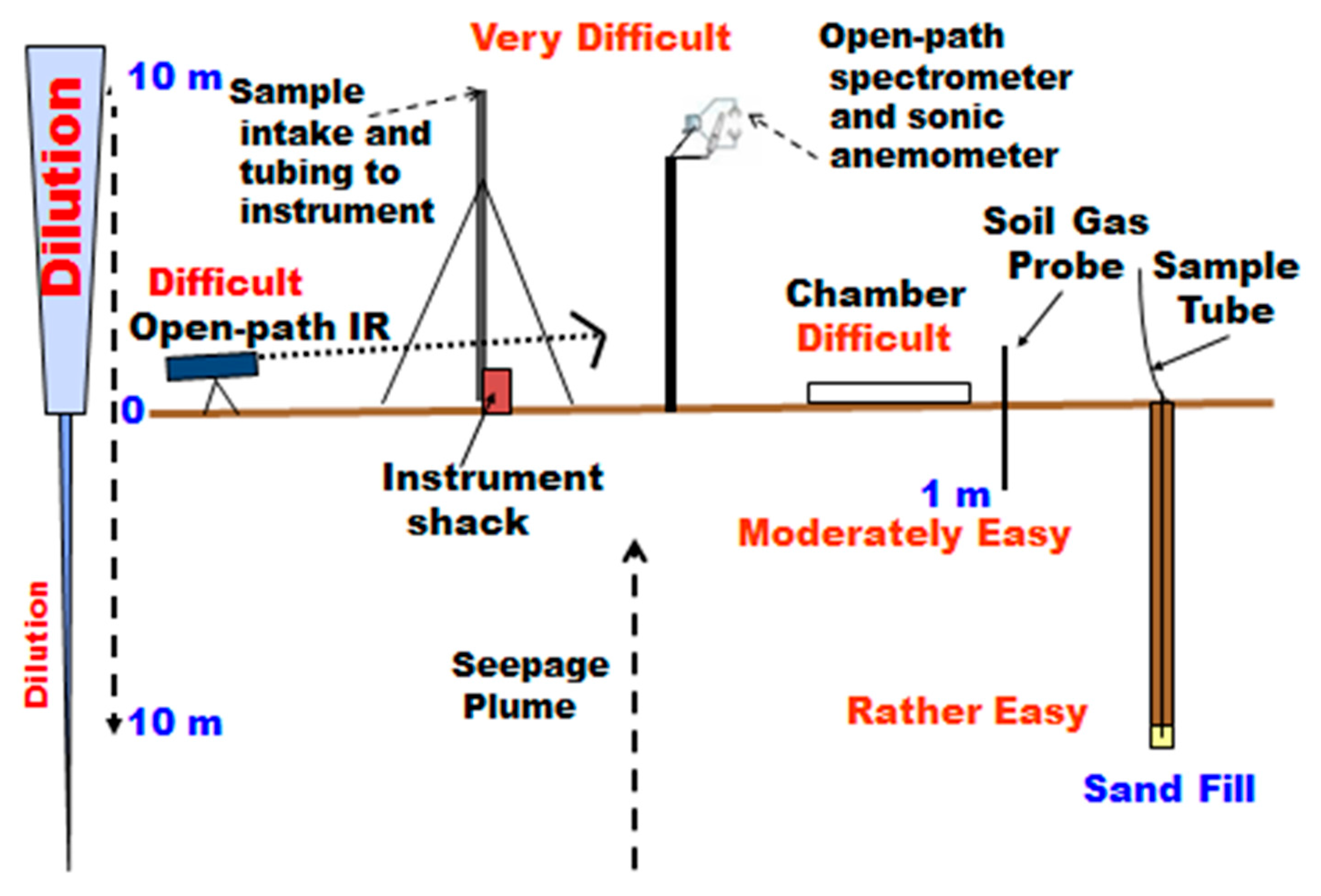
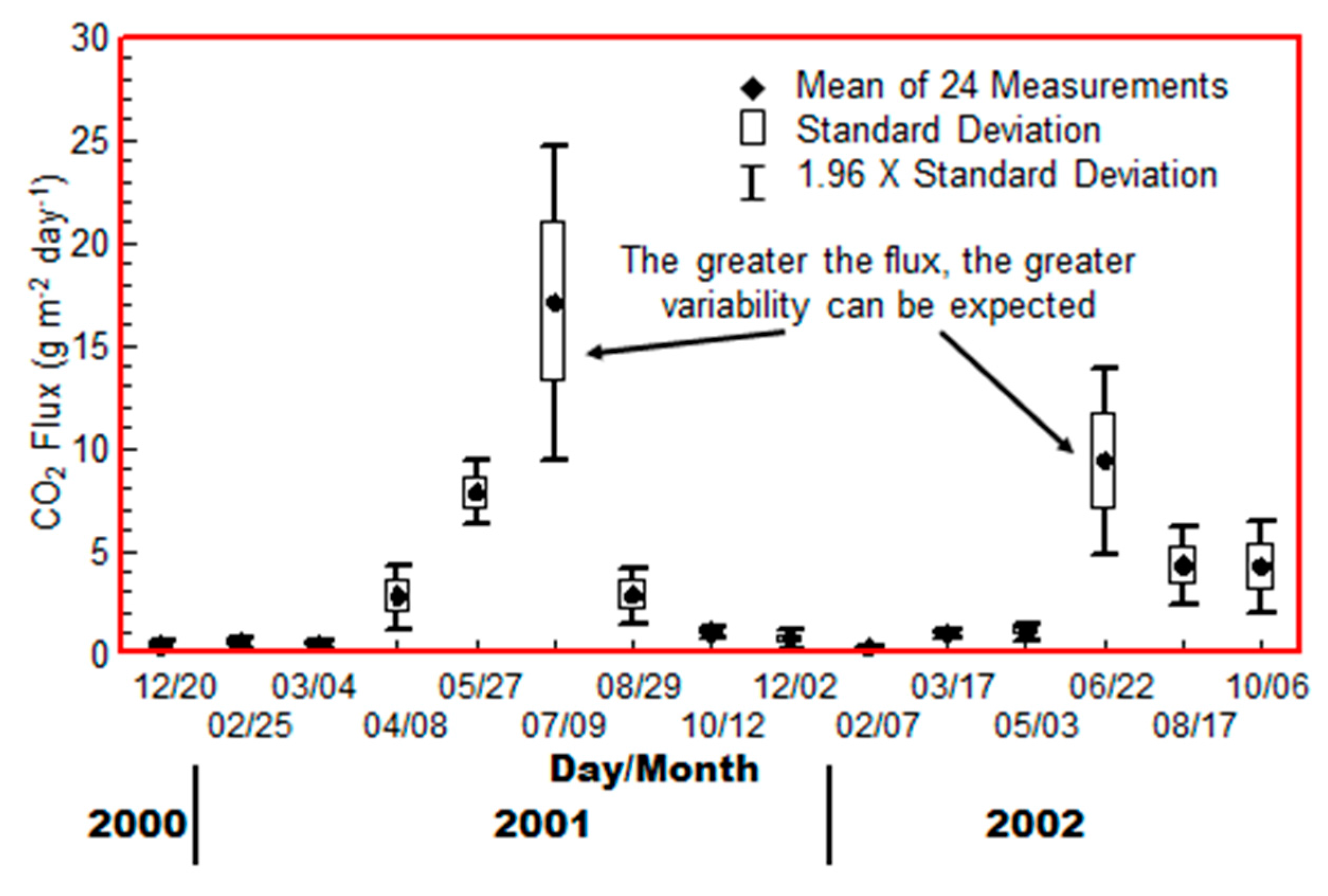

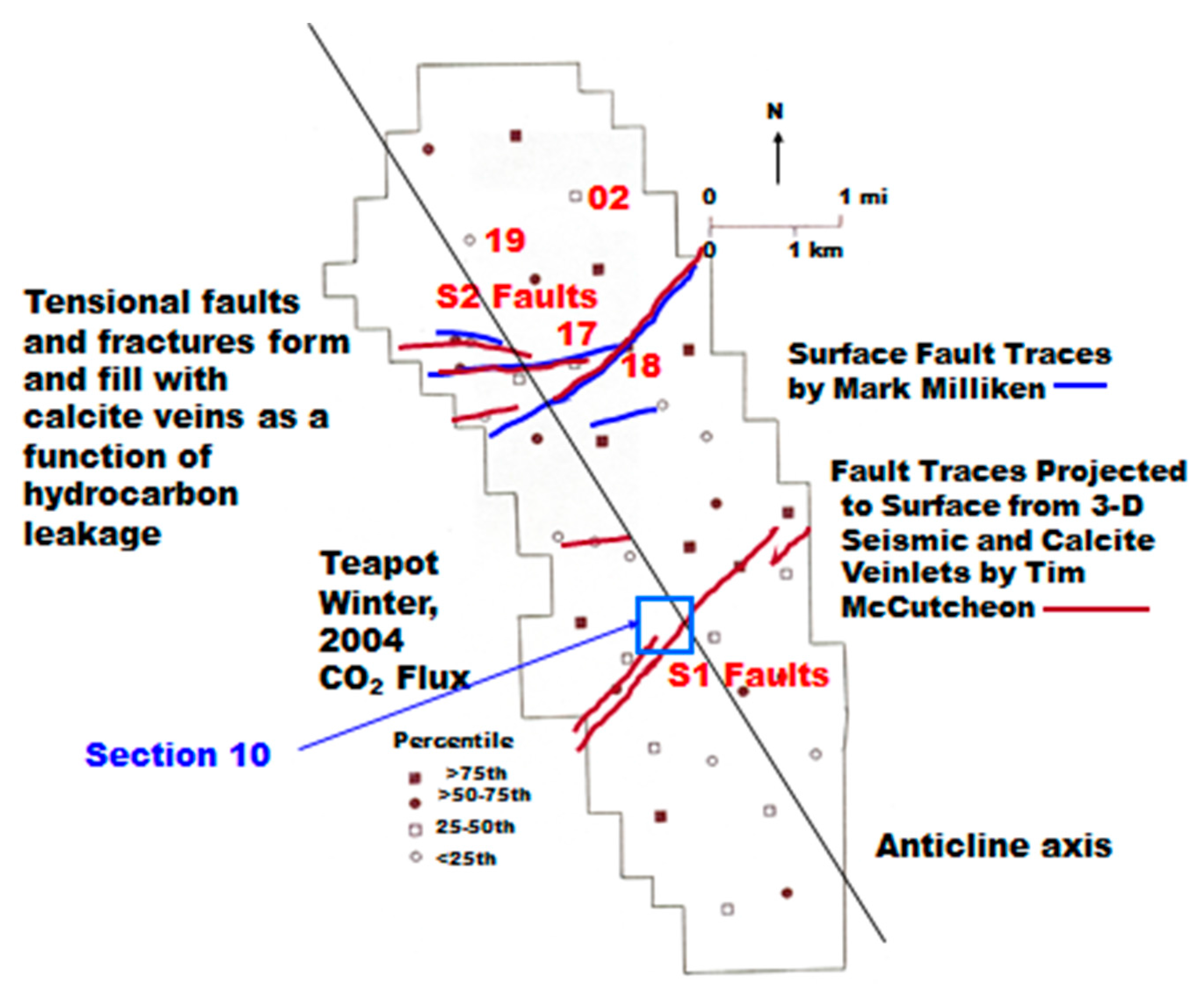
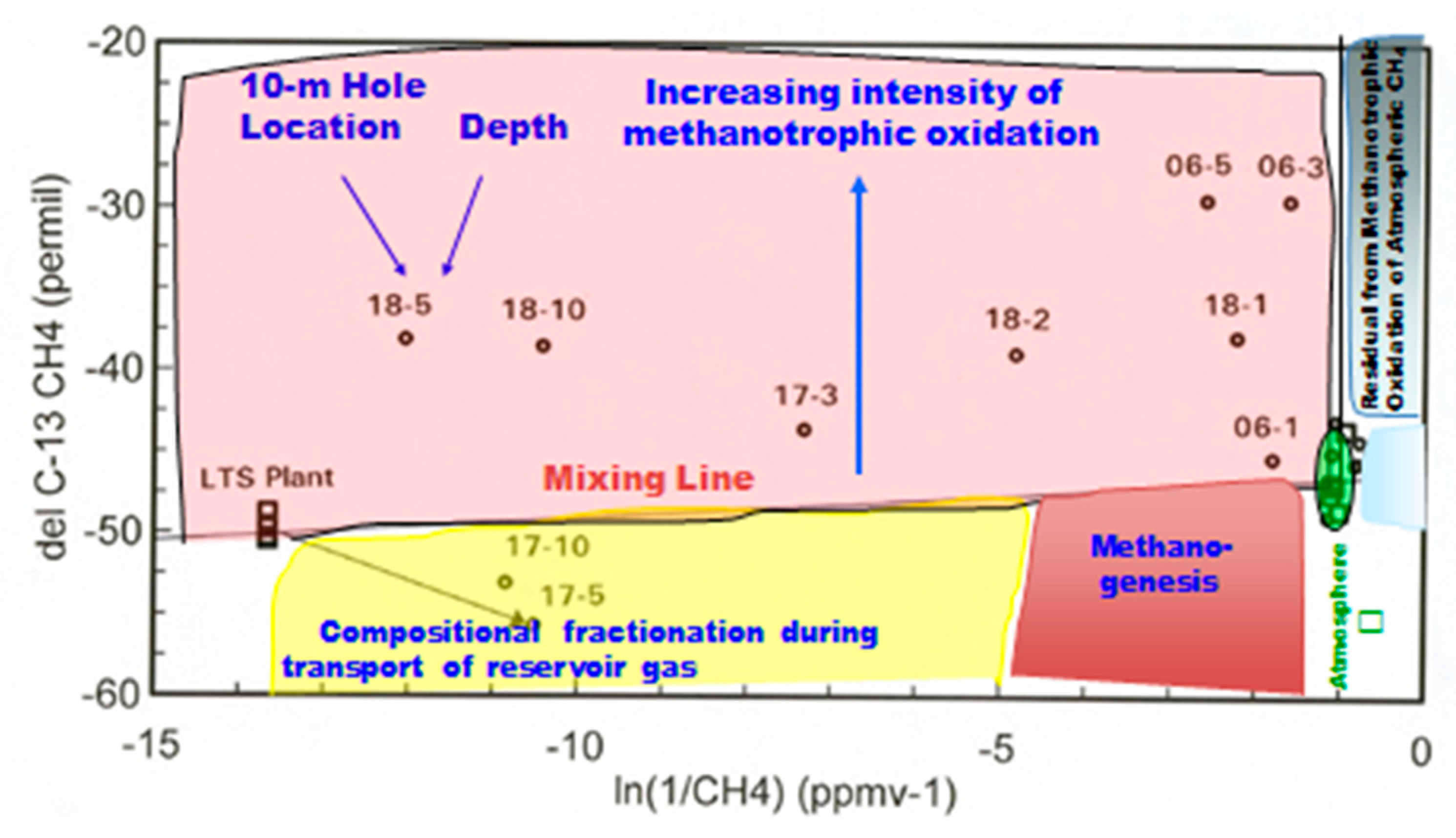
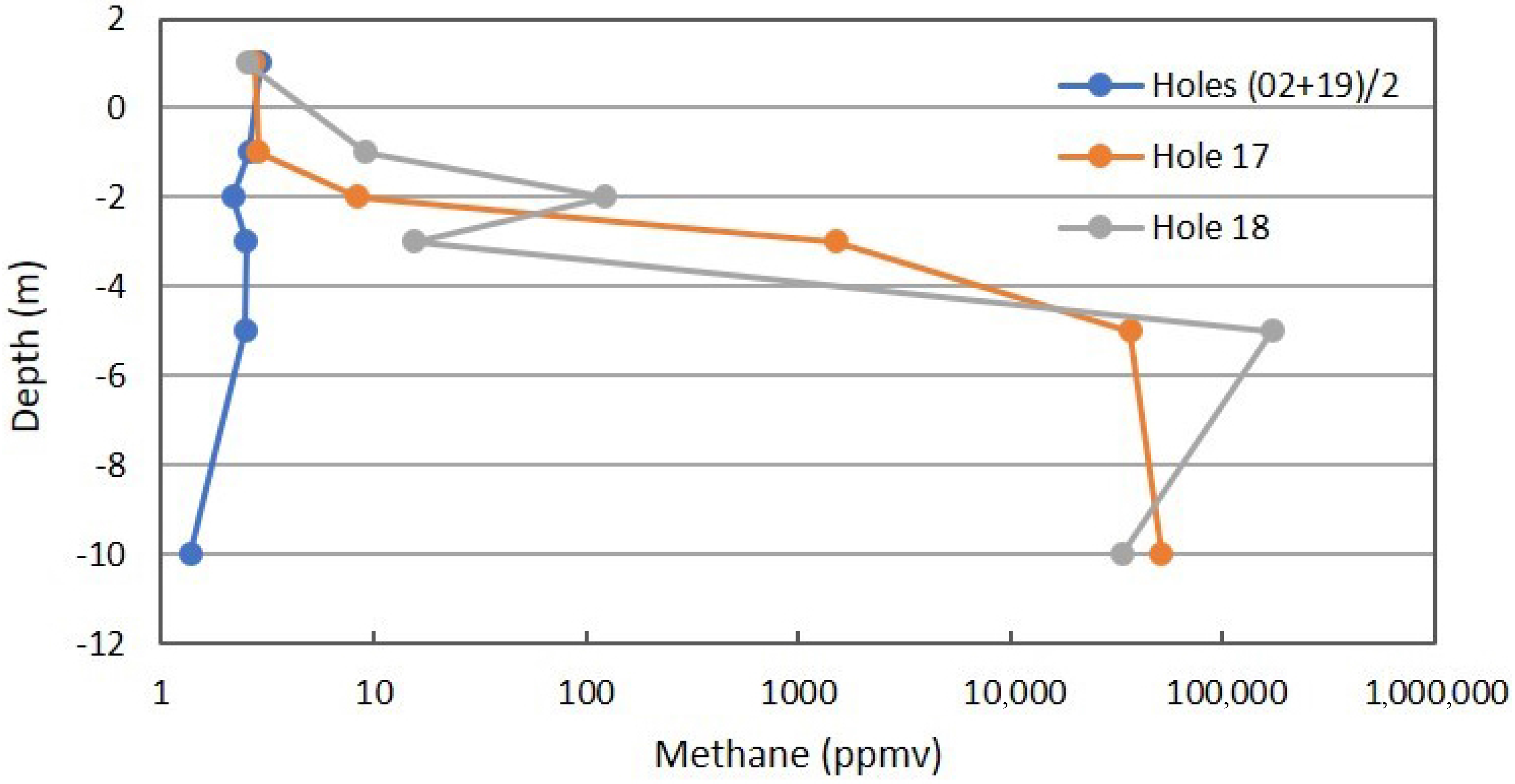
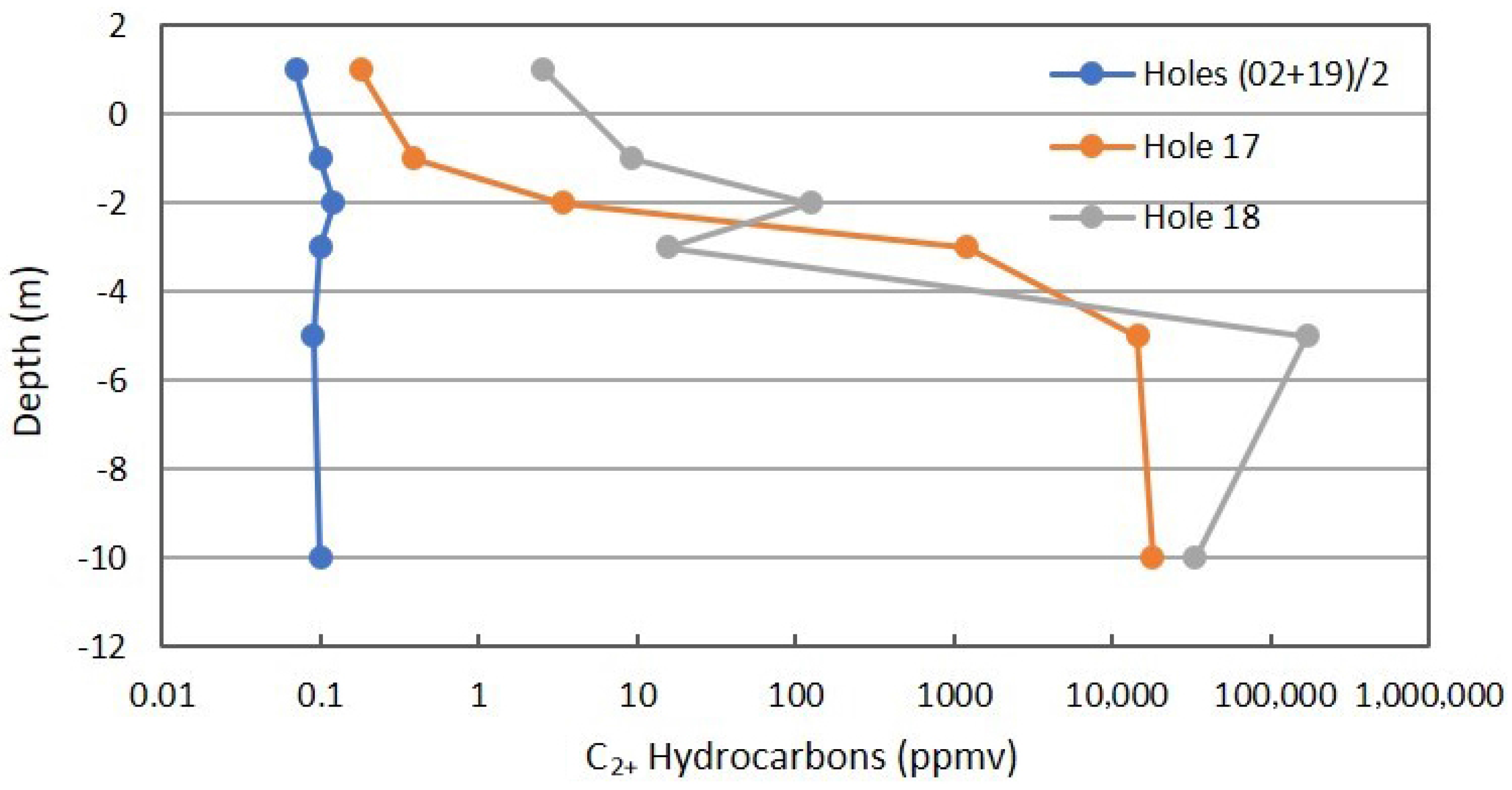
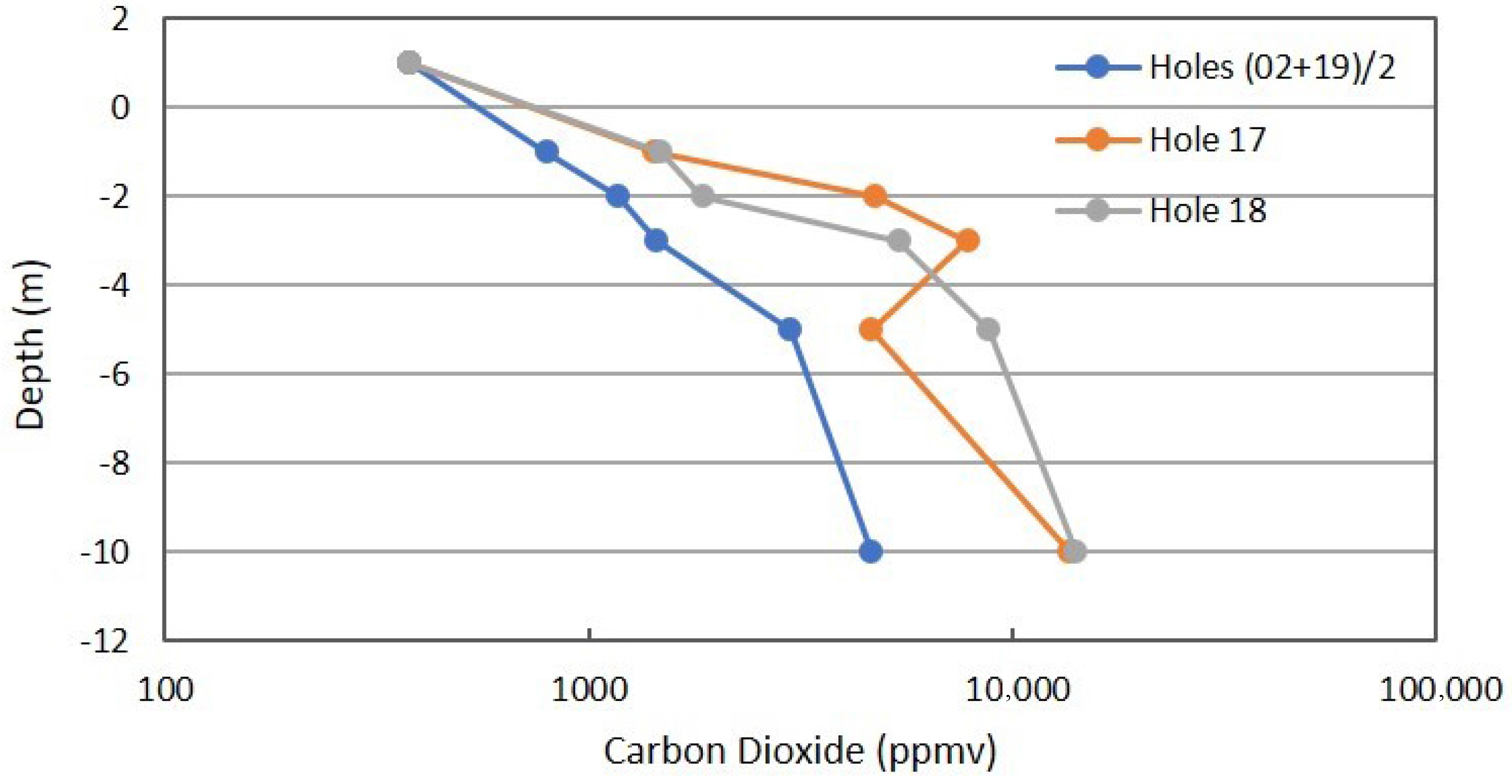
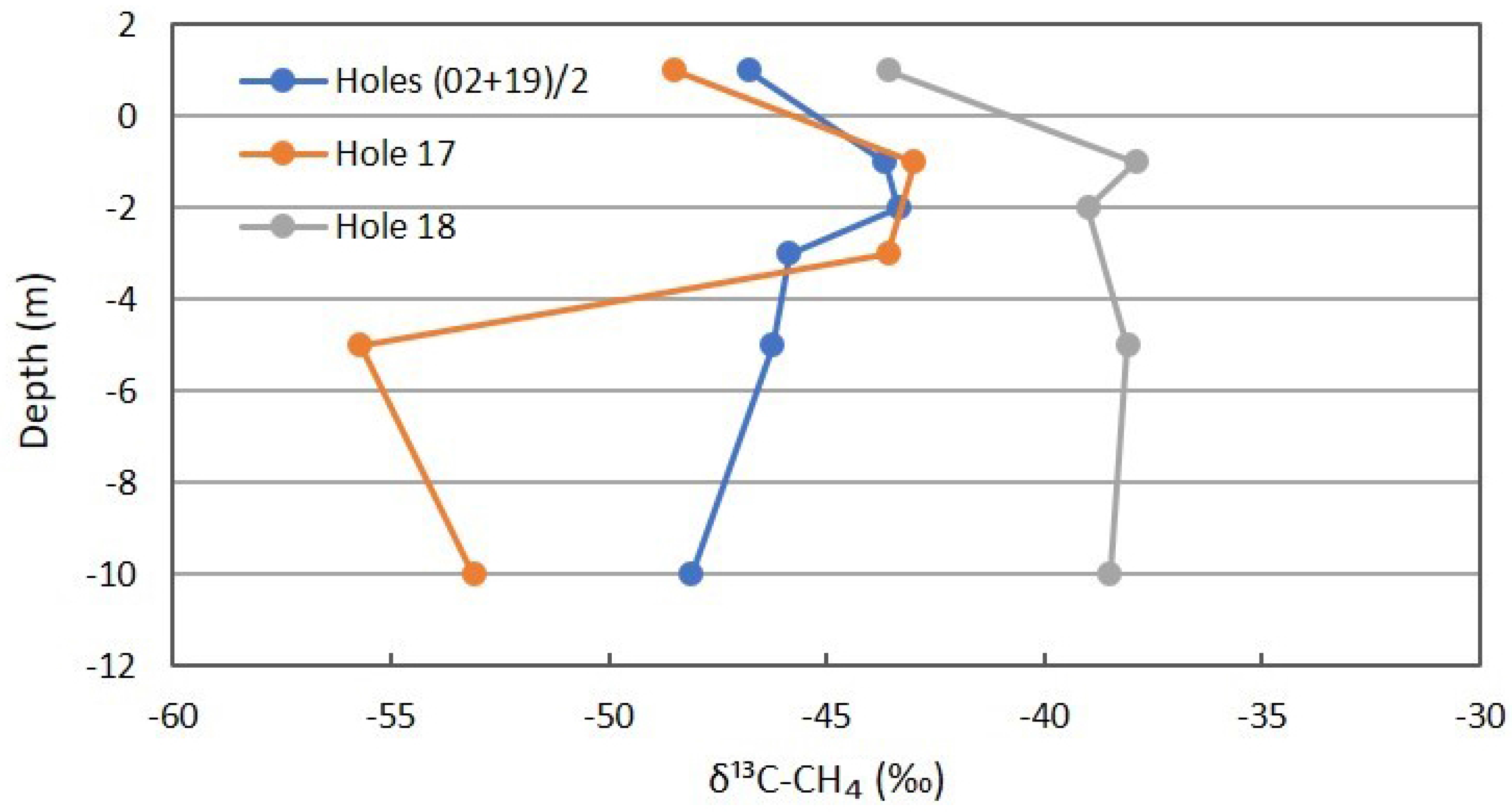
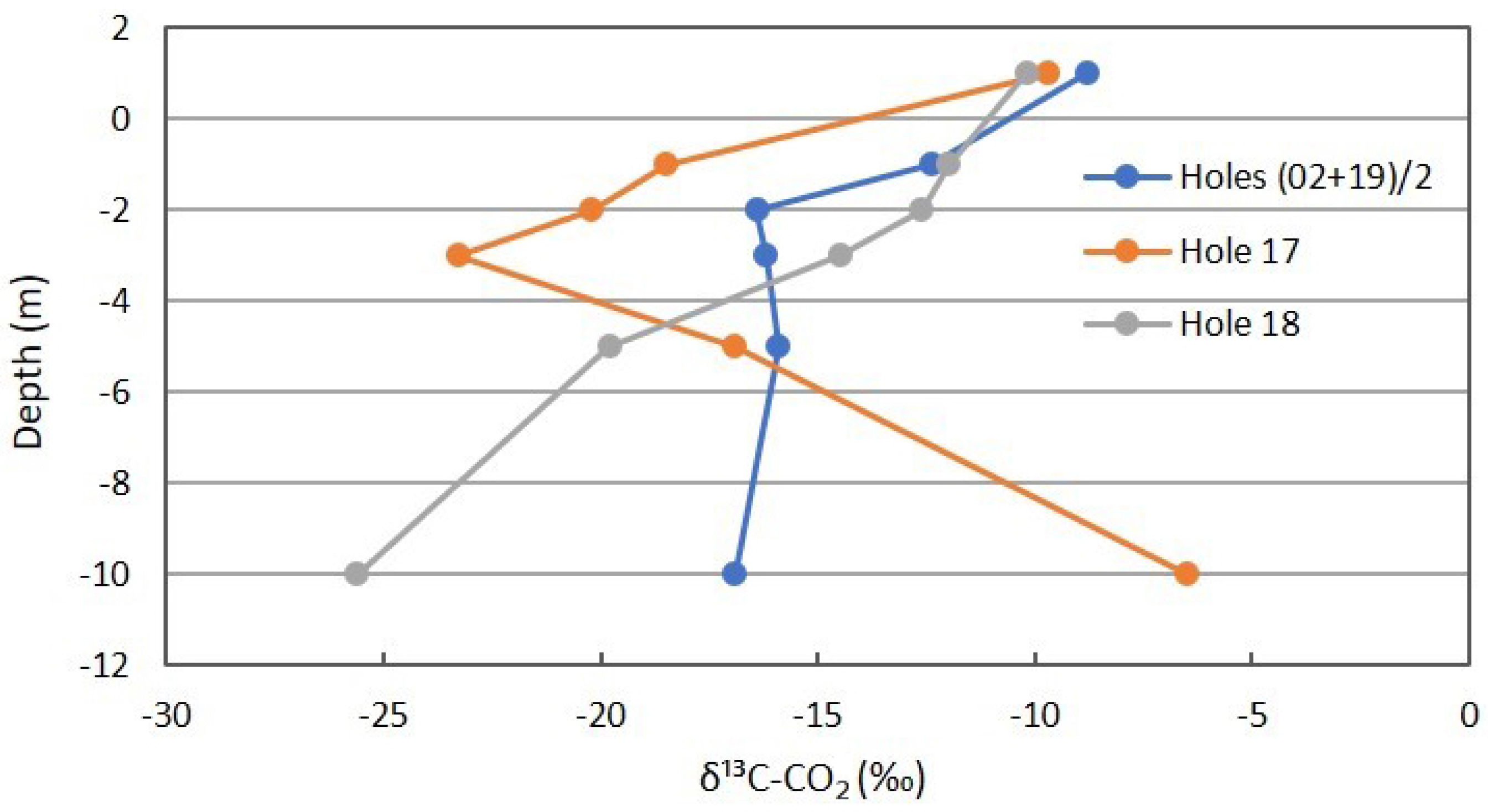
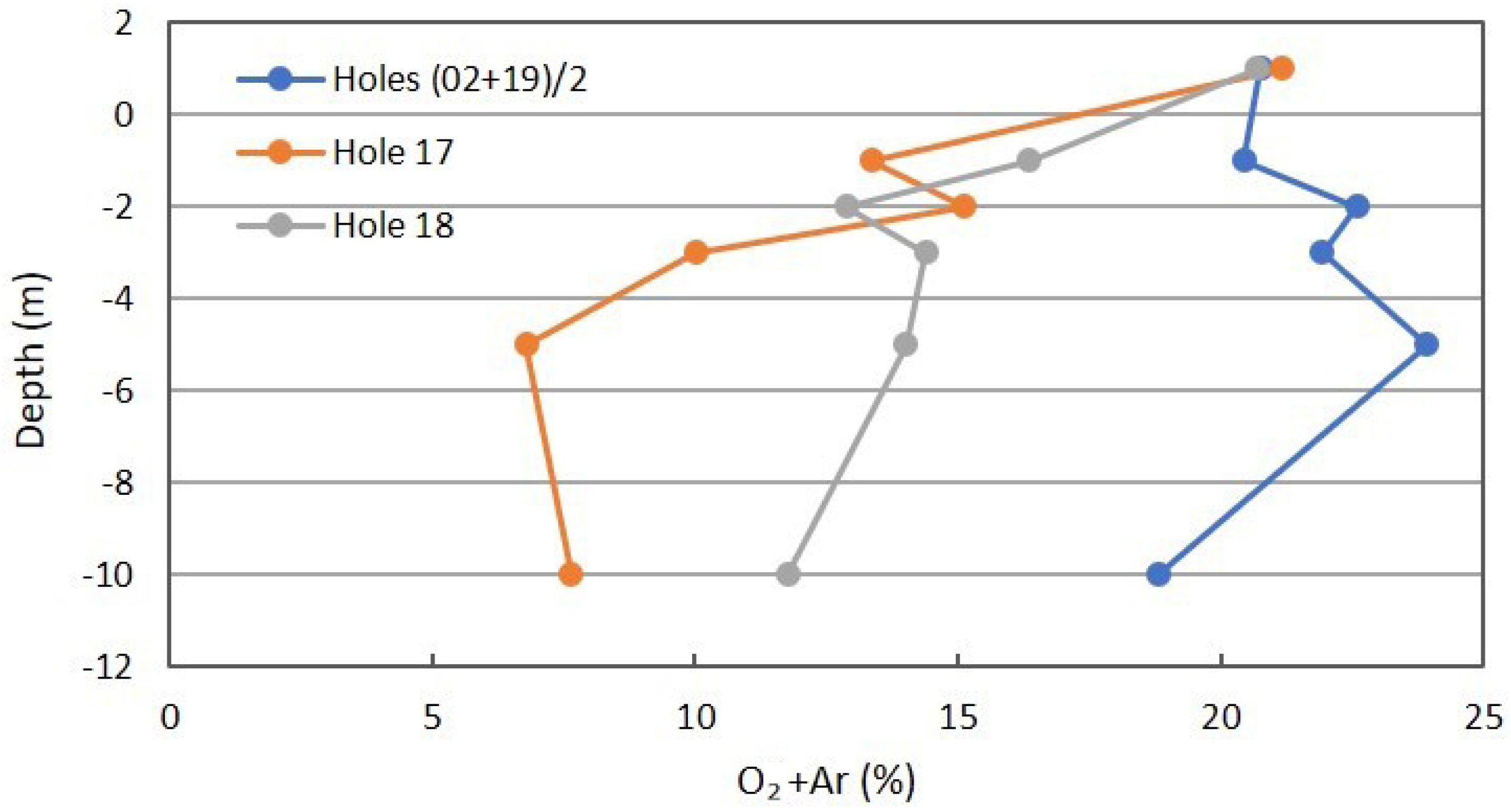
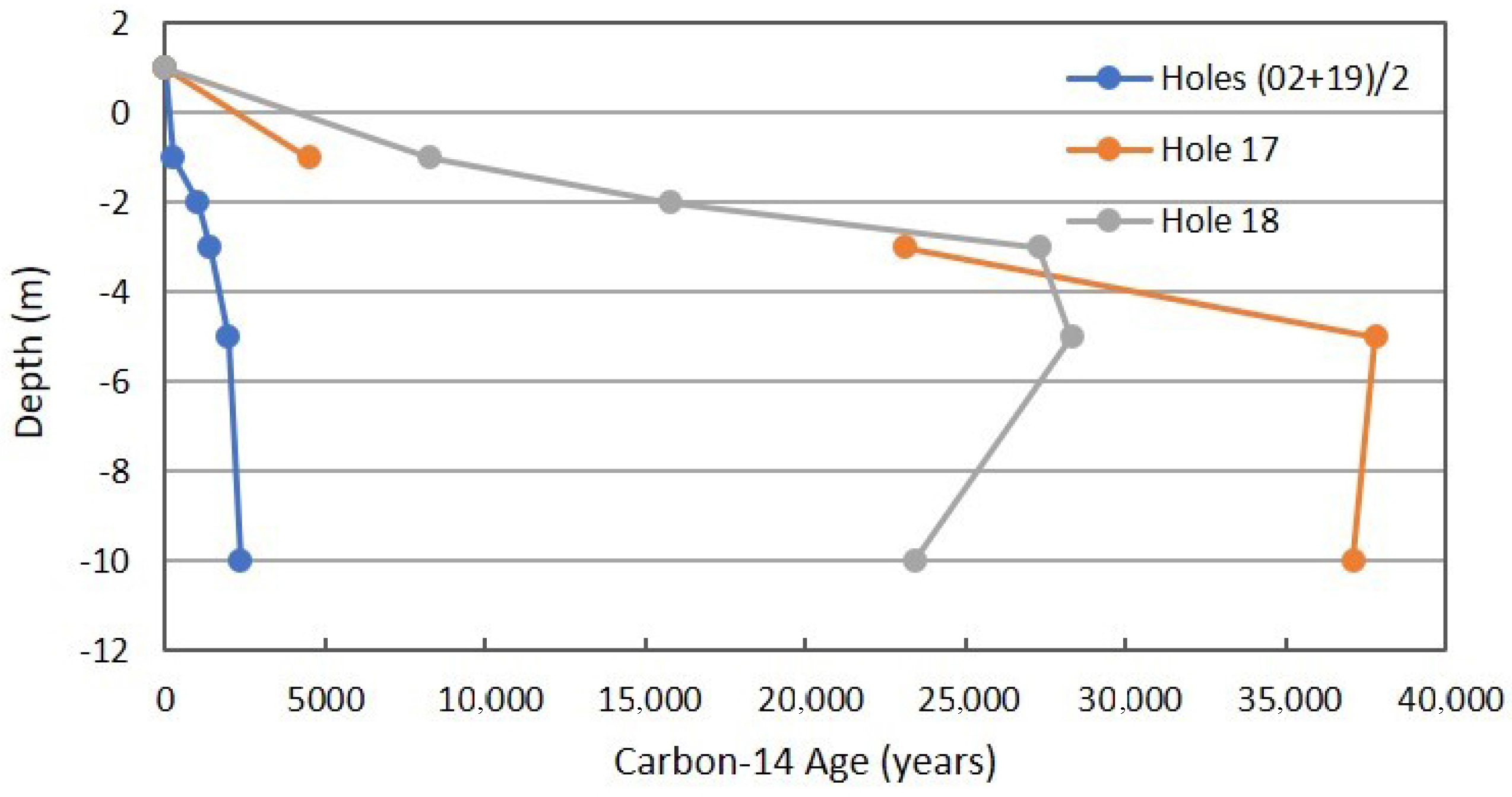
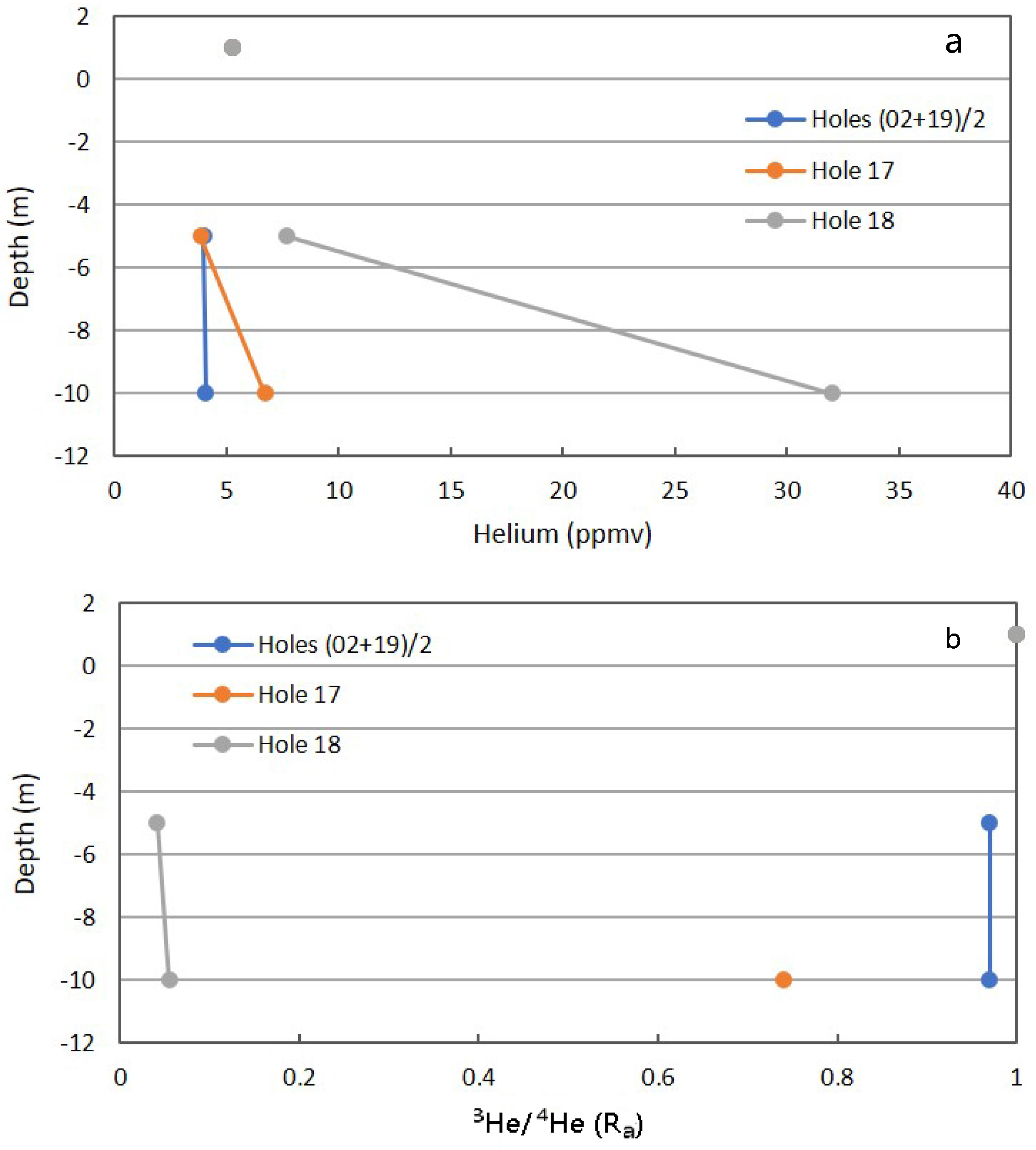

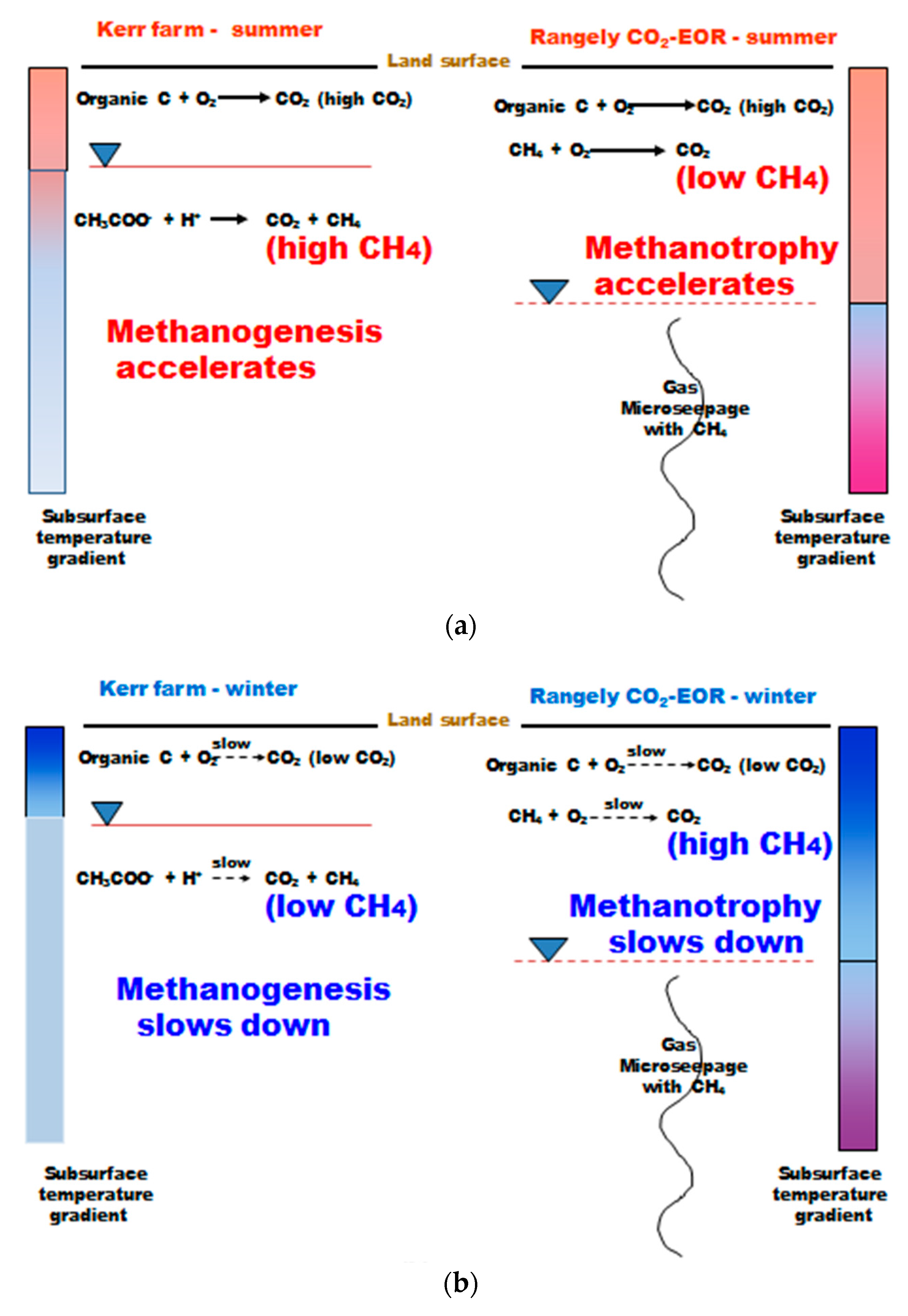
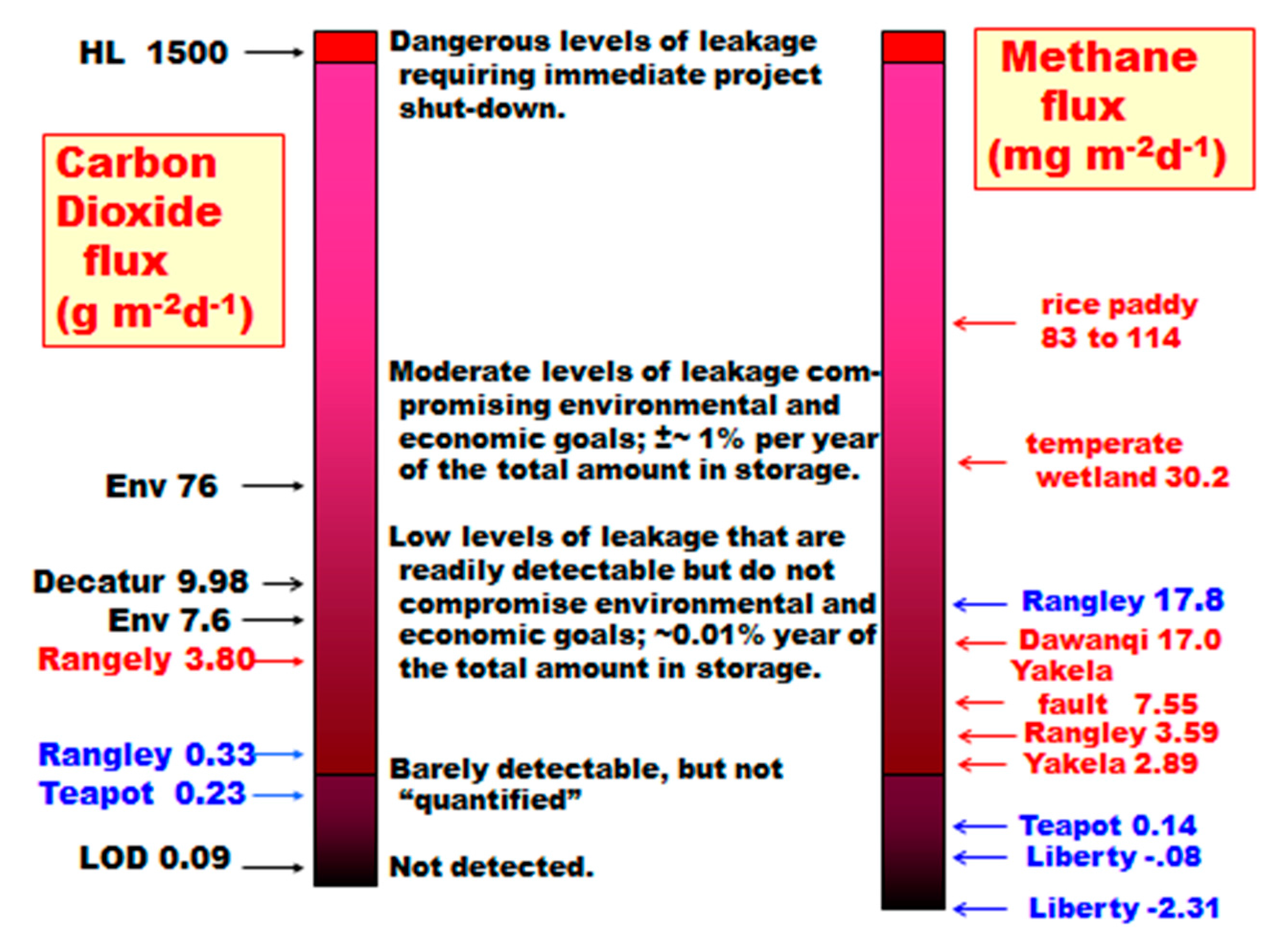
| Parameter | n (Rangely) | n (Teapot) |
|---|---|---|
| Reconnaissance Surveys | 2000–2002 | 2004 |
| CO2 and CH4 fluxes-triplicate fluxes 10-m apart | 59 1 | 40 |
| CO2 and CH4 in soil gases at 30-, 60-, and 100 cm depths | 67 | 40 |
| δ13C of CO2 in soil gas at 30-, 60-, and 100 cm depths | 67 | 40 |
| CH4, CO2, and δ13C of CO2 in an atmosphere sample | 59 | 40 |
| δ13C of CO2 in Klusman breath twice per day during sampling 10-m holes | 2001–2002 | 2005–2007 |
| CO2, CH4, C2+ alkanes and alkenes, O2+Ar, δ13C of both CO2 and CH4, C-14 of purified CO2 | 5 2 | 5 2 |
| Inert gases concentration and isotopic ratios | 5 3 | 5 3 |
| Miscellaneous measurements | 2000–2002 | 2003–2005 |
| Shallow soil temperatures at 15-, 30-, 60-, 100-cm | 4 4 | 4 4 |
| 10-m hole temperature at 1-, 2-, 3-, 5-, 10-m depths | 5 | 5 5 |
| Soil moisture at 15-cm intervals from surface to 2-m depth | 2 6 | 2 6 |
| Soil gas porosity and permeability at 15-cm intervals from the surface to 2-m depths | 2 6 | 2 6 |
| Barometric pressure—1-h interval, 24 h/day at a fixed location during all field work | 1 7 | 1 7 |
| δ13C and δ18O of CaCO3 in five 10-m hole depth intervals | - | 50 |
| δ13C of native vegetation | variable | variable |
| Section 10 study at Teapot Dome in 2007 | ||
| CO2 and CH4 in soil gases at 30-, 60-, and 100-cm depths | 50 | |
| δ13C and 18O of CaCO3 from miscellaneous samples in faults | - | variable |
| Rangely Field | Teapot Dome | |||||||||||
|---|---|---|---|---|---|---|---|---|---|---|---|---|
| Summer | Winter | Summer | Winter | |||||||||
| Rangely Field | Mean | Med. | SD | Mean | Med. | SD | Mean | Med. | SD | Mean | Med. | SD |
| CO2 flux | 4187 | 3560 | 3574 | 307 | 67.9 | 1134 | - | - | - | 227.1 | 214.1 | 186.9 |
| CH4 flux | 4.86 | 0.440 | 22.8 | 25.1 | 0.87 | 135 | - | - | - | 0.137 | 0.102 | 0.325 |
| Rangely Control Area | No Control Area Because of Underpressure | |||||||||||
| CO2 flux | 2525 | 2616 | 847 | 429 | 62.0 | 742 | - | - | - | - | - | - |
| CH4 flux | 0.636 | 0.620 | 1.51 | 1.34 | 0.753 | 1.99 | - | - | - | - | - | - |
| Rangely Field | Teapot Dome | |||||||||||
| CO2 in soil gas | 2897 | 2650 | 1759 | 1015 | 596 | 1246 | - | - | - | 1010 | 719 | 1194 |
| CH4 in soil gas | 21.70 | 2.73 | 110 | 10.18 | 2.76 | 26.97 | - | - | - | 0.92 | 0.96 | 0.09 |
| Rangely Control Area | No Control Area Because of Underpressure | |||||||||||
| CO2 in soil gas | 2079 | 2106 | 942 | 840 | 534 | 570 | - | - | - | - | - | - |
| CH4 in soil gas | 2.89 | 2.46 | 2.13 | 9.02 | 2.77 | 24.47 | - | - | - | - | - | - |
| Teapot Dome-s04 | Rangely-s01 | Teapot Dome-w04 | Rangely-w01/02 |
|---|---|---|---|
| CO2 flux and 30-cm soil gas | 0.266 1 | 0.151 | 0.135 |
| CO2 flux and 60-cm soil gas | 0.252 1 | 0.231 | 0.268 |
| CO2 flux and 100-cm soil gas | 0.093 | 0.446 2 | 0.339 2 |
© 2018 by the author. Licensee MDPI, Basel, Switzerland. This article is an open access article distributed under the terms and conditions of the Creative Commons Attribution (CC BY) license (http://creativecommons.org/licenses/by/4.0/).
Share and Cite
Klusman, R.W. Faults as Windows to Monitor Gas Seepage: Application to CO2 Sequestration and CO2-EOR. Geosciences 2018, 8, 92. https://doi.org/10.3390/geosciences8030092
Klusman RW. Faults as Windows to Monitor Gas Seepage: Application to CO2 Sequestration and CO2-EOR. Geosciences. 2018; 8(3):92. https://doi.org/10.3390/geosciences8030092
Chicago/Turabian StyleKlusman, Ronald W. 2018. "Faults as Windows to Monitor Gas Seepage: Application to CO2 Sequestration and CO2-EOR" Geosciences 8, no. 3: 92. https://doi.org/10.3390/geosciences8030092




